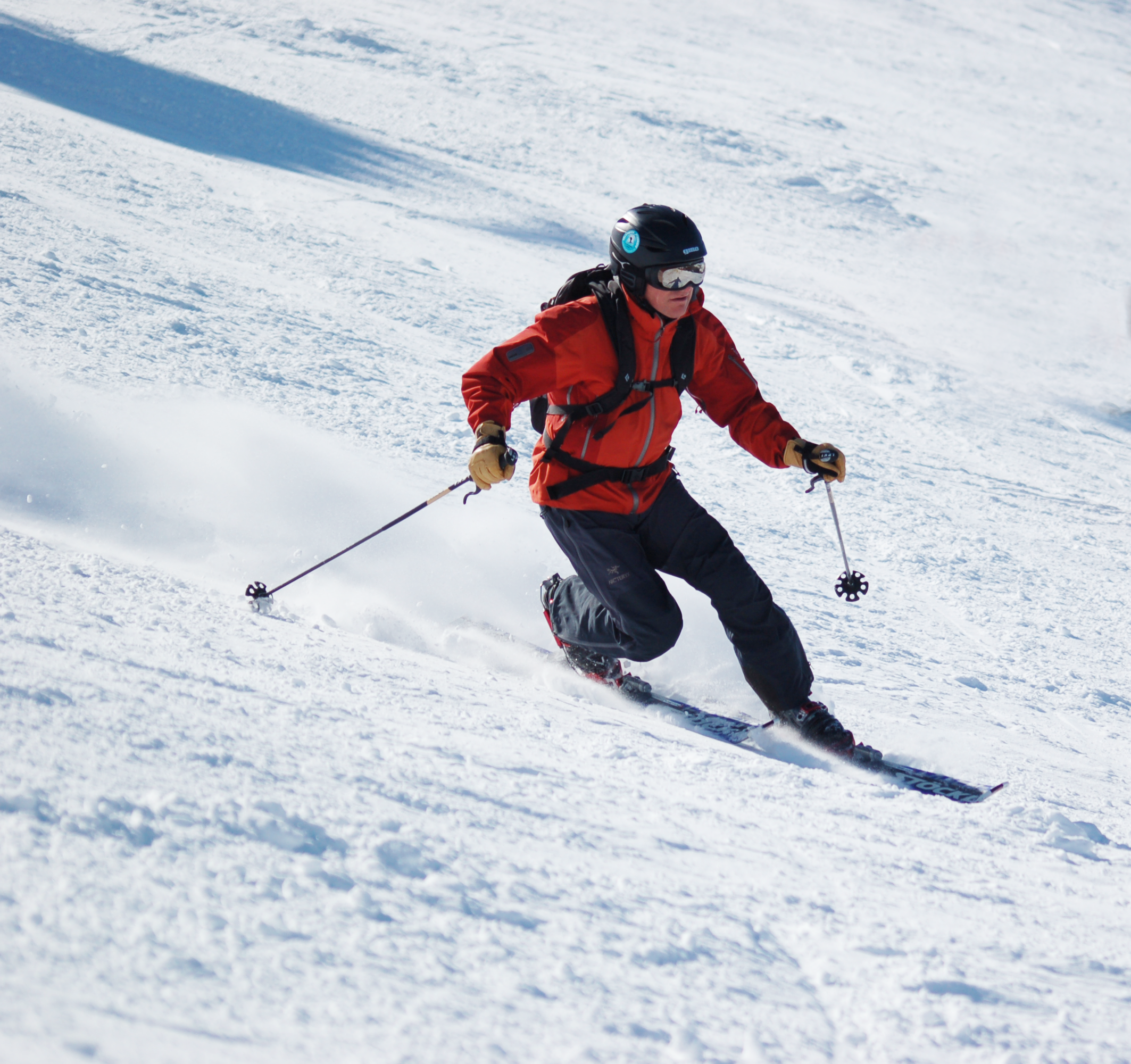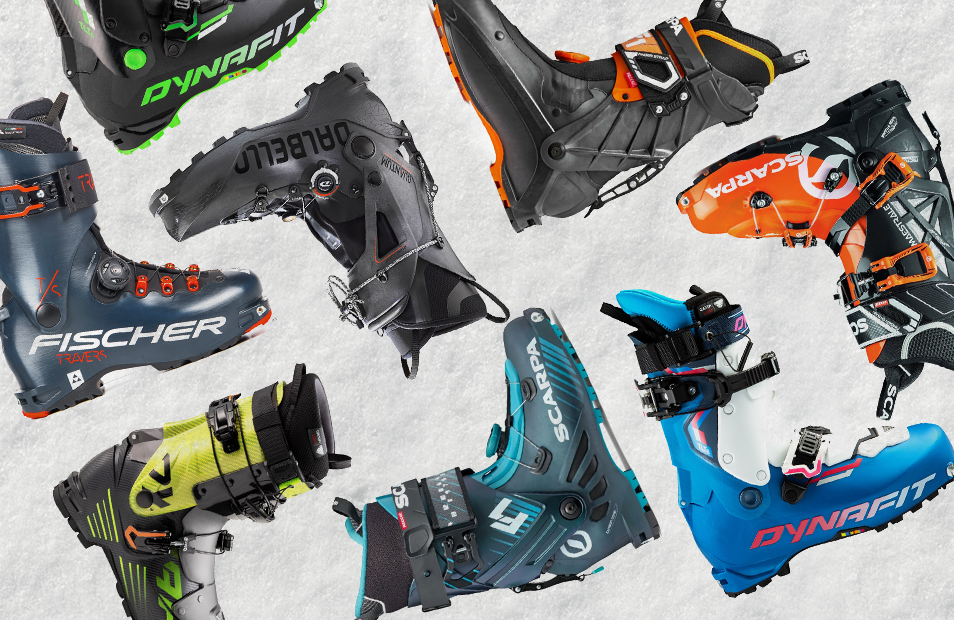
Alpine touring boots can be divided into three categories depending what style of ski touring you'll be doing.
RACE boots are very light, extremely expensive, moderately uncomfortable and often pretty fragile!!
EFFICIENT boots are light and designed allow natural striding when climbing and provide good downhill control when used with narrow to medium-wide touring skis.
FREE RANDO boots look more like alpine ski boots with a shell / tongue / upper cuff construction and with 3 or 4 buckles.
These boots are heavier and offer a high level of downhill control, supplying the power required to ski wider touring skis, but are harder work when skinning up.
We recommend that most people start touring with skis 80-90 mm at the waist and for these skis the EFFICIENT boots are the best choice for most people.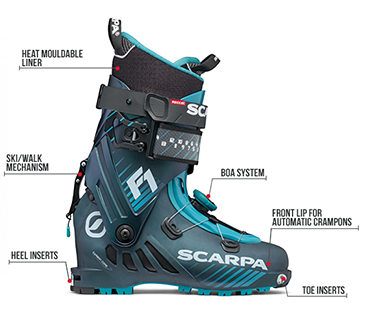

Efficient ski boots can be divided into two categories, boots derived ski touring race boots, and boots derived from more traditional 3 or 4 buckle alpine ski boots.
The first look similar to ski touring race boots. These have only 1 or 2 buckles, which may be interlinked with the ski-walk mechanism, or use the Boa system instead of buckles. A good example is the Scarpa F1, above left.
Advances in designs and materials have enabled the manufacturers to create light boots with sufficient stiffness for powering narrow to medium-wide touring skis.
The more traditional touring boots look more like alpine ski boots, with 4 or 4 buckles, but are made with lighter materials and more cuff rotation to allow efficient touring. Many manufacturers will produce a series of boots with increasing stiffnesses. For example the Scarpa Maestrale (above right) is only slightly heavier than the race inspired designs, can be used with efficient skis and provides a higher level of downhill control, while the Scarpa Maestrale RS has a stiffer, tongue and cuff and is destined for use with wider touring free-touring skis.
Before we look at this year's boots, let's consider what a touring boot has to do. A good touring boot has to fulfill the following requirements:
1 - Low weight.
Touring boots have to weigh as little as possible so that you can climb effectively. While weight is relatively unimportant for downhill boots, minimal weight is essential for touring.
Manufacturers use advanced polymers to create boot shells that are light yet rigid over the temperature ranges encountered when touring. Many top-end boots use Pebax for the shells, while some are now using a polymer called Grilamid which allows the creation of more compact shells that feel more like a walking boot than a ski boot. Boot designers have found clever ways to get efficient closure with the minimum number of buckles, and link buckle closure with activating the ski / walk mechanism. Most models have heat mouldable liners which are lighter than traditional liners.
Most Efficient touring boots weigh between 2.0 and 2.5 kg per pair, while Free Rando boots will weigh 3.0 kg or more.

2 - Comfortable and warm.
You'll be using wearing these boots for several hours, maybe for several days running, and comfortable boots let you concentrate on the skiing. It's important to choose a boot that's going to be comfortable all day yet give good control when the buckles are clamped down for skiing. The width of the last (foot form) used when making boots varies between brand and even between models, so it's worth trying several pairs to be sure that you've found the boot best suited to your feet.
Most AT boots now use foam inner boots or liners which can be heated up then moulded to the shape of your feet. These liners are light and warm and once moulded are comfortable (before moulding they can feel a bit hard).
Liners can have a traditional tongue design or an Overlap design. The traditional tongue design gives better mobility in walk mode, so the ankle can flex forward and back during each stride, so is used for most Efficient boots.
Some Free Rando boots have Overlap liners, which give a more snug closure around the lower leg for more control when skiing.

3 - Walkability.
Unlike an alpine ski boot with it's flat, hard sole, alpine touring boots have a rockered sole to give an efficient stride and a rubber outer sole that grips well so you can walk pretty much normally.
4 - Cuff Articulation.
All alpine touring boots have a ski / walk mechanism at the back of the boot cuff & shell. In ski mode this locks the cuff in a forward position, like that of an alpine ski boot, so that we can apply power to the ski.
In walk mode the mechanism unlocks the cuff so it can move freely backwards and forewards with the leg, making each stride as efficient as possible.
5 - Control & Safety.
The boot has to offer good downhill control and release safely from the bindings in the event of a fall. Alpine skiers going touring for the 1st time often find the level of control with touring boots lower, but once you've made a few descents you'll find that the boots do work well. All efficient touring boots have "inserts" at the boot toe and heel for use with insert bindings. (take a look at TP's blog Ski Touring 101 #2 Bindings for more info about these). Some models can also be used with plate bindings, and even alpine bindings with toe units that have height adjustable AFDs (anti-friction devices) like the Marker Squire/Griffon/Jester family. Most of the latest generation efficient boots have compact toe designs and can only be used with insert bindings.
Boot Sizing.
All boots have a footbed or inner sole inside the liner, which provides a stable platform for the foot. Alpine touring boots use the Mondopoint system (MP) of sizes, which refers to the length of the footbed in cm.
A size 27 MP boot has a footbed 27 cm long, a size 28.5 MP boot a 28.5 cm footbed.
Most touring boots are made in full and half sizes, 26, 26.5, 27, 27.5 MP, however some brands (Atomic, Fischer) only make one size per shell size, 26/26.5 MP, 27/27.5 MP, the idea being that the foam liner can adapt sufficiently when moulded to adjust at least a half size.
Most people need a boot with a footbed 5-10 mm longer than the length of their foot when measured by backing the heel up against a vertical stop and measured to the front of the longest toe.
People with particularly wide feet may need to go up a shell size to get a comfortable fit, while skiers with bone spurs or other problems can require a visit a specialist boot fitter to have the shells enlarged.
OK OK, you've read all this stuff, but which boots do you need to get started?!!
The following models are all good boots, the comments explain their main characteristics.



Scarpa F1 and Scarpa F1 Women
Scarpa's F1 has been the best selling AT boot in France for several years and with good reason.
Light with massive amounts of cuff articulation for easy climbing, the F1 has two cuff straps with Velcro plus the Boa system for precise closure.
Scarpa is licenced to use the latest Dynafit toe inserts with a vertical slot that does make step-in easier than the basic inserts found on older boots.
For gram counting fanatics Scarpa also make the F1 LT, an even lighter version which weighs only 990 g per boot size 27 MP and has a slightly narrower last (100mm compared to 102mm).
Available in men's and women's versions, the F1 is an excellent boot.

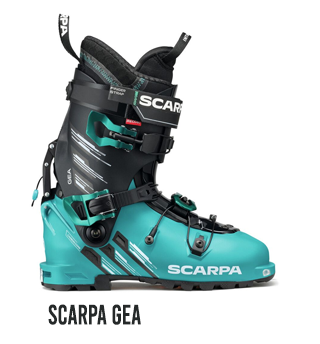
Scarpa Maestrale (men) & Scarpa Gea (women)
Scarpa's Maestrale and Gea boots have been updated with subtle updates for 2024, making these excellent boots even better. Scarpa make 2 Maestrale / Gea models, the standard Maestrale / Gea with a flex of 100 and the stiffer Maestrale RS / Gea RS which are destined for use with wider free rando skis. These boots have three buckles plus a Velcro strap combined with a stiff yet light cuff, giving these boots plenty of power while the 60° cuff movement, while less than the lighter models above, is more than many touring boots. These boots are a good choice should you be looking for a more powerful boot offering mor control downhill and are willing to heft a bit more weight uphill.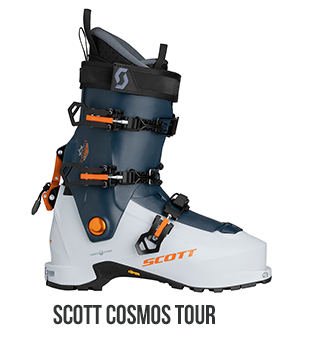
Scott Cosmos Tour
The Cosmos has been a popular boot for several years. A wide high volume boot, this is often the only boot people with wide feet are comfortable in, and that's why we stock it, comfort being more important than low weight or the degree of cuff articulation. That said, it's true that the design of the Cosmos dates from some years and its' performance is well below that of the Maestrale, for example.
We hope this article is useful but should you like help deciding what's best for you then get in touch, we're here to help.
We can send gear to Andorra, no problem. The best way to choose boots is to try them, so if you can come to our shop in Ax you can be sure to get the best fit and we can mould the boot liners for you.
We recommend buying skis and bindings using TP's Alpine Touring Package deals. Each package is chosen to offer compatible skis and bindings at the best possible price.
We mount bindings and trim skins to the shape of your skis free of charge, just tell us the make, model and mondopoint size of your touring boots.



